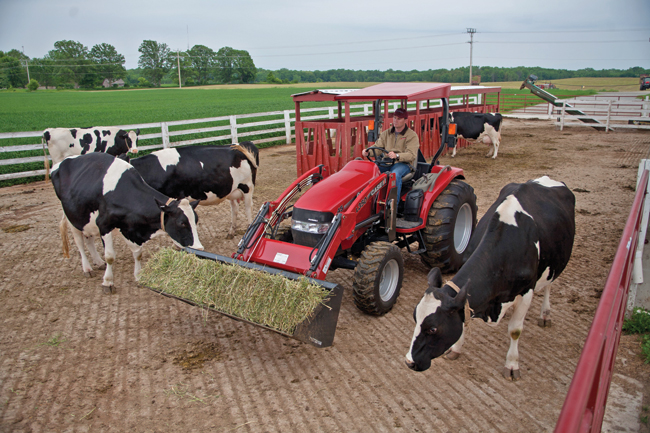Keep It Clean
Efficiency is key when accomplishing chores. From dropping off a pile of gravel in the yard to spearheading bunk feeding in the barn, a compact tractor can be your ultimate chore-conquering piece of equipment. With an implement off the front, mid or rear of the machine, compact tractors allow operators to swiftly change attachments and applications. Implements make the tractor utilitarian, so it’s vitally important to keep the tractor and its attachment systems maintained and running properly.
Effectively maintaining the machine is important. Before doing maintenance work on a compact tractor, operators should read the owner’s manual and inspect the equipment daily.

As always, timely and consistent maintenance will improve the equipment’s functionality and productivity. Starting with the front attachment system, owners and operators should be sure to grease the loader at its pivot points, connections between the loader and the tractor and between the loader and the attachment. Keep in mind, all dirt should be cleared from the fittings before they are greased. Using a grease gun helps, especially if it is filled with high-grade multipurpose grease. Greasing should be done every 50 to 100 hours.
Weight plays a big role in the capability of a loader and its attachment, and maintaining the proper ballast is vital to the operation of the loader and the tractor. A counterweight provides stability, increases safety and comfort and reduces the rocking motion of a heavy-laden load with a compact tractor. Operators can use rear-wheel weights or ballasting boxes filled with sand or gravel to balance a bucket or pallet fork full of spoils and products, which should never exceed the total recommended weight for the tractor. They also can fill their rear tires with liquid, like a calcium chloride and water solution, but operators always should consult their dealer first. If weight is added to the tractor for proper balance, tire pressure must be considered or the tractor may be damaged. Operators also need to follow capacity guidelines. Such hard work always deserves a reward. If your compact tractor gets dirty lifting and hauling through the mud and dust, be sure to clean it up.
As with any tractor, making sure your Power Take Off system (PTO) works and is operated properly will ensure success for the season. Pay attention to instructions on how to use a PTO. For example, some manufacturers do not recommend engaging the PTO at full engine rpm because it would put a massive amount of stress on the machine. Be careful around PTO systems and attachments. Some tractor safety systems are better than others. For instance, some PTOs will stop if you leave the seat while under operation — like with a mid-mount mower — but some rear-mount PTOs run without the operator needing to be in the seat. Regardless of how the PTO operates, avoid loose clothing or hair that can get caught in moving parts and leave shields and safety mechanisms in place.
Performing preventative maintenance according to the operator’s manual can go a long way. After all, PTO systems involve mechanical linkages, so keeping them properly lubricated is a critical factor in performance and longevity. And talk to your dealer about the availability of replacement parts and service. The PTO system on your tractor is critical to your ability to get most jobs done. That’s why manufacturers put a lot of research into the PTO and why anyone buying attachments should think about the PTO system that will drive the attachment.
Greg Lucey is the Case IH marketing manager for small tractors, loaders and implements, based in Racine, Wis.
